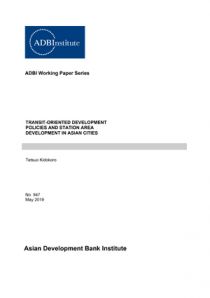Transit-Oriented Development Policies and Station Area Development in Asian Cities

-
Includes:
-
Published
May 2019
Many metropolitan cities in Asia are planning and implementing extensive investment in mass transit networks and thus are now on the threshold of becoming transit cities or car traffic saturation cities. The promotion of transit-oriented development (TOD) policies will be a key to the progression to transit cities. TOD should consider a transit-oriented regional growth management plan, station area zoning regulations (mixed-use, minimum density, maximum parking, etc.), joint development among local governments, transit agencies, and private developers, and an institutional mechanism for public and private cooperation in station area development.
We examine cases from cities in Japan, the United States (US), and Southeast Asia, including Tokyo and Toyama in Japan, Denver in the US, and Kuala Lumpur in Malaysia. We conclude that the following are factors for the successful implementation of TOD in Asian cities: a shift from highway-based zoning to transit-oriented zoning; the creation of an institutional mechanism for public and private cooperation in station area development; a balance between public benefit and private benefit; the connection of transit services and affordable housing; and multi-modal connection planning, including walking.
